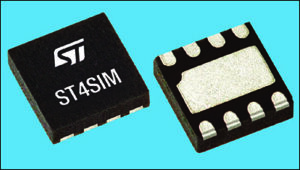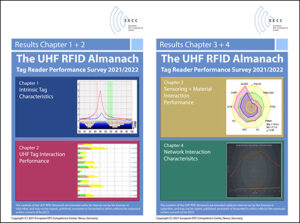Presented here are recent news announcements regarding the following organizations: Parsl, NXP Semiconductors, Avery Dennison SmarTrac, STMicroelectronics, Balluff, Star Systems International, Kerlink, NetOP Technology and the European EPC Competence Center.
Parsl, NXP, Avery Dennison SmarTrac Form Strategic Partnership
Cannabis company Parsl, RFID and NFC tag manufacturer Avery Dennison Smartrac, and RFID and NFC semiconductor chip maker NXP Semiconductors have announced a strategic partnership to help the cannabis industry communicate effectively and securely. This partnership, according to the companies, will combine Parsl’s intellectual technological property with the manufacturing capabilities of NXP and Avery Dennison.
 Parsl says this will enable it to provide verifiable insights to cannabis consumers and grow market share. Customers in Africa, Australia, Europe and the United State scan expect to see Parsl-Smartrac tags on products and on their favorite growers’ plants, the companies predict. The combination of Avery Dennison’s and Parsl’s technologies form a platform for Parsl customers, they explain, granting access to international products of verifiable quality.
Parsl says this will enable it to provide verifiable insights to cannabis consumers and grow market share. Customers in Africa, Australia, Europe and the United State scan expect to see Parsl-Smartrac tags on products and on their favorite growers’ plants, the companies predict. The combination of Avery Dennison’s and Parsl’s technologies form a platform for Parsl customers, they explain, granting access to international products of verifiable quality.
As part of a long-term strategy, the companies hope to provide secure, verifiable data for everyone throughout the cannabis supply chain, from grower to consumer. “I’m proud that we, at Parsl, are working with the top RFID supplier in the world,” says Isaac Balbin, Parsl’s founder and CEO, in a prepared statement. “Through our partnerships with Avery Dennison Smartrac and NXP, we are working with the best-quality products so that our customers always have the information they need at the scan of a tag.”
“It’s been an exciting journey so far working with the creative team at Parsl and seeing this NFC-enabled solution come to life,” added Marcel Cote, Avery Dennison Smartrac’s director of sales and market development for the Asia Pacific region, in the prepared statement. “A great example of two innovative companies collaborating effectively by combining their unique technology solutions and capabilities to solve global industry challenges.”
STMicroelectronics Unveils Industrial eSIM for M2M IoT
STMicroelectronics, a semiconductor company for electronics applications, has announced the mass-market availability of its ST4SIM embedded SIM (eSIM) ICs for machine-to-machine (M2M) applications through e-distribution. The eSIMs, according to the company, provide the services required to connect Internet of Things (IoT) devices to cellular networks, and are suitable for such applications as machinery condition monitoring, predictive maintenance, asset tracking, energy management and connected healthcare devices.
 By allowing remote management of the SIM profile in accordance with the GSMA specification, the eSIMs let customers change connectivity providers without having access to the device. “With rich built-in features and access to world-class provisioning services, our ST4SIM family delivers a convenient solution for numerous M2M applications,” said Laurent Degauque, the marketing director of STMicroelectronics’ Secure Microcontroller Division, in a prepared statement. “Mass-market availability now lets developers everywhere leverage secure and flexible cellular connectivity in more applications than ever, including independent M2M development, proof-of-concept and prototype projects.”
By allowing remote management of the SIM profile in accordance with the GSMA specification, the eSIMs let customers change connectivity providers without having access to the device. “With rich built-in features and access to world-class provisioning services, our ST4SIM family delivers a convenient solution for numerous M2M applications,” said Laurent Degauque, the marketing director of STMicroelectronics’ Secure Microcontroller Division, in a prepared statement. “Mass-market availability now lets developers everywhere leverage secure and flexible cellular connectivity in more applications than ever, including independent M2M development, proof-of-concept and prototype projects.”
Using STMicroelectronics’ B-L462E-CELL1 Discovery Kit, powered by the ST4SIM, users can test and evaluate product features pre-integrated in an ecosystem. The ST4SIM is certified by GSMA and manufactured at ST’s GSMA SAS-UP accredited sites in Europe and southeast Asia. It is available in an MFF2 DFN8 wettable flank package measuring 5 millimeters by 6 millimeters (0.2 inch by 0.24 inch). Other options are available, including a miniaturized wafer-level chip-scale package.
Balluff Offers High-Speed RFID Read-Write Heads
Balluff has announced that its RFID read-write heads are designed to provide condition and diagnostic data through a range of condition-monitoring capabilities, in addition to high-speed reading and writing of data carriers. Built-in condition-monitoring features include vibration detection, inclination detection, internal temperature monitoring, signal quality check, and voltage and current monitoring.
By providing data regarding machine condition, the company explains, these features enable users to optimize the performance of their machines and facilities. The collected data can help users determine preventative maintenance needs, as well as improve processes and efficiencies, minimizing downtime and reducing costs. The read-write heads are part of Balluff’s Smart Automation and Monitoring System (SAMS) product line, which include condition-monitoring features and IO-Link data-reporting capabilities in washdown-ready housings. The heads are designed for track and trace, production control, and automatic interchangeable part assignment and detection.
The heads come in four sizes—models M12, M18 and M30, as well as a flat design—and use IO-Link COM3 with a maximum transmission rate of 230.4 kBaud to read from and write to data carriers. Designed for harsh industrial environments, are IP68- and IP69K-rated, they have washdown and ECOLAB approval. The heads come with Balluff’s Washdown Plus promise, enabling them to withstand at least 1,000 cleaning cycles. They include an operating hours counter, a boot cycle counter, and ping for visual location.
Star Systems International Intros E-Tolling Transponder
Star Systems International (SSI), a provider of smart-city products, has announced the launch of its Astro Premium transponder, certified for interoperability in e-tolling systems. The transponder can be attached to a vehicle’s windshield or headlamp, the company reports, and it offers high sensitivity, a large user memory bank and security features. It is tested and certified for conformance and interoperability for tolling, is Gen2V2-compliant, and comes with self-error-detection capability.
“These self-data error-detection features give Astro market-leading reliability,” said Stephen Lockhart, SSI’s CTO, in a prepared statement. “They flag one- or more-bit errors, should they occur. Reducing errors improves back-office efficiencies. This is beneficial for improving operational costs, as well as maintaining good customer relations. In addition, the large 512-bit user memory bank is perfect for applications that require extra memory.” The Astro can withstand harsh environmental conditions, such as long exposure to sunlight and wide temperature ranges.
“Adding Astro to our transponder offerings provides our customers with the best options in meeting their system’s needs,” Lockhart added. “This best-in-class product allows us to provide more value to our customers and it reflects our commitment to stay at the forefront of technological development.” Astro is suitable for AVI applications, such as electronic tolling collection and congestion pricing, and is currently available for order.
Kerlink, NetOP Technology Create IoT-Based Wildfire-Prevention System
Kerlink, a provider of solutions for the Internet of Things, and NetOP Technology, which produces IoT systems for multiple verticals and applications, are collaborating on a wildfire-prevention system designed to warn public officials when weather conditions predict fires. NetOP has been Kerlink’s product distributor since July 2018.
This summer, more than 187,000 fires have been recorded worldwide, the companies report, underlining the urgency of acting on global warming. Extreme temperatures and droughts have fueled fires in Russia, Greece, Sicily, Algeria, Tunisia, the Amazon, Mozambique, Zimbabwe, Canada and the United States, particularly in California, where the Dixie Fire has been burning since mid-July and has ravaged more than 200,000 hectares (494,200 acres).
To identify risk areas, the LoRaWAN-based system combines Kerlink’s Wirnet gateways with NetOP’s Forest Capsules, which measure such meteorological conditions as humidity, temperature, carbon dioxide and the concentration of volatile organic compounds, using built-in sensors. The long-range wireless device detects, collects and reports dangerous conditions, even in remote locations, via Kerlink’s LoRaWAN gateways, while its AI capabilities identify fire outbreaks by their GPS location.
The system’s dashboard features an integrated AI layer, sensors with machine-learning functions, forest fire prediction, online risk calculation, live maps of terrain, real-time heat maps and alarm scenarios. “Our technology and Kerlink’s very wide LoRaWAN coverage allow forest and wildlands managers to expand their monitoring far beyond traditional capabilities of smoke detection and early fire observation,” said Olcay Taysi, NetOP Technology’s cofounder, in the prepared statement. “By predicting where fires are likely to start, the Forest Capsule system helps officials spend their monitoring and surveillance activities more effectively.”
“This solution delivers on the global scale by helping to anticipate climate change consequences potentially resulting in vast fires, and locally it protects wildlife and enables organizations to conserve water and other resources used in fighting fires,” added Romain Weryk, Kerlink’s key account manager, in the statement. “Kerlink’s expertise on gateways and communication management is widely recognized for the robust performance those features deliver in diverse and challenging environments, and they make Kerlink an obvious partner for this world’s-first, IoT wildfire-prevention application.”
EECC Publishes UHF RFID Almanac
The European EPC Competence Center has announced that its “EECC UHF RFID Almanac” provides strategies and approaches for RFID systems. In the latest edition of its international study (previously called the “UHF Tag Performance Survey”), the performance of 550 tags is correlated to 36 readers. The study contrasts technical and economic developments on the chip and transponder side to readers from a variety of manufacturers, the organization reports. The almanac available is to new customers for €995 ($1,175) per issue as part of a five-year subscription, or €1,495 ($1,766) for a single copy. Comprising results from more than six million measurements, it reflects most scenarios in which RFID can be used, the EECC reports.
 “Leading transponders, such as Impinj’s Monza M700 series and NXP’s UCODE 8, continue to dominate the market,” the EECC indicated in a prepared statement. “The good news is that we see increasing competition at the top of the market. This, of course, is urgently needed, given that chip availability continues to be severely limited worldwide.” In such an environment, users must switch between similarly performing transponders with alternative chip types, sometimes at great risk, according to Conrad von Bonin, EECC’s CEO. “With the Almanac, however, suitable replacements can easily be identified through overview diagrams from the data of more than 550 examined transponders,” he said in the prepared statement.
“Leading transponders, such as Impinj’s Monza M700 series and NXP’s UCODE 8, continue to dominate the market,” the EECC indicated in a prepared statement. “The good news is that we see increasing competition at the top of the market. This, of course, is urgently needed, given that chip availability continues to be severely limited worldwide.” In such an environment, users must switch between similarly performing transponders with alternative chip types, sometimes at great risk, according to Conrad von Bonin, EECC’s CEO. “With the Almanac, however, suitable replacements can easily be identified through overview diagrams from the data of more than 550 examined transponders,” he said in the prepared statement.
Nam Anh Tran, EECC’s lab director, added in the statement: “The backlink matrices of the Almanac resolve these questions according to several influencing variables at the same time, which is one of its unique features. Whether tags can be used in large populations, for example, or how they work in different read scenarios; without the Almanac, users typically only optimize one of these dimensions. It is so much easier to just look up the information rather than to take educated guesses, or worse, make poor decisions.”
In the past, the key criteria for reader selection were form factor, size and price, but for the current edition, the almanac examines the readers’ radio characteristics. The EECC examined 36 models and classified them into three categories: standard, specialty and handheld. “Reader sensitivity can often be the decisive difference for a successful RFID application,” said Ramy Hagouan, EECC’s head of RFID applications, in the prepared statement. “With the overviews and diagrams of the almanac, it is now possible to see directly which reader fits which tag in which application.”


